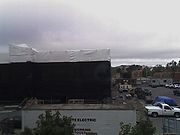
Greyfield land
Encyclopedia

Real estate
In general use, esp. North American, 'real estate' is taken to mean "Property consisting of land and the buildings on it, along with its natural resources such as crops, minerals, or water; immovable property of this nature; an interest vested in this; an item of real property; buildings or...
assets or land. The term was coined in the early 2000s as a way to describe the sea of empty asphalt that often accompanied these sites. "Greyfield" is a relative neologism when compared to more commonly known terms such as brownfield
Brownfield land
Brownfield sites are abandoned or underused industrial and commercial facilities available for re-use. Expansion or redevelopment of such a facility may be complicated by real or perceived environmental contaminations. Cf. Waste...
s or greenfield
Greenfield land
Greenfield land is a term used to describe undeveloped land in a city or rural area either used for agriculture, landscape design, or left to naturally evolve...
s.
The term has historically been applied to formerly viable retail and commercial shopping sites (such as regional malls and strip centers) that suffer from lack of reinvestment and have been "outclassed" by larger, better designed, better anchored malls or shopping sites. This retail-centric application to greyfields may also be referred to as "dead mall
Dead mall
A dead mall or greyfield is a shopping mall with a high vacancy rate or a low consumer traffic level, or that is dated or deteriorating in some manner. Many malls in the United States are considered "dead" when they have no surviving anchor store or successor that could serve as an entry into or...
s" or "ghostboxes" if the anchor or other major tenants have vacated the premises leaving behind empty shells.
Unlike brownfields (which feature actual or perceived levels of environmental contamination), greyfields typically do not require remediation in order to unlock value to an investor. The hidden value, in many cases, is the presence of underlying infrastructure (such as plumbing and sewer, electrical systems, foundations, etc.) allowing a developer to improve the site more efficiently through major or minor capital expenditures that may lead to increased rents and greater value. Other important potential qualities include parking, a central location, etc. may also be leveraged in a well-executed redevelopment of the site.
Some greyfields may also be considered favorable to investors because, even though they are outclassed or physically in disrepair, they may have revenue in place through long or short term leases. Greyfields with short term leases may work well for an investor/developer who has a strategy involving intensive real estate asset management. By actively managing the greyfield in a short-term lease environment, rents may be increased after improvements are made.
The greyfields term may also be applied more broadly to urban infill or commercial locations where underuse or outdated (non-retail) uses hamper an otherwise valuable real estate asset. An example would be a formerly industrial waterfront site that is potentially valuable as a mixed use/residential site as it is being encroached upon by residential sprawl, or other economic or redevelopment pressures. In this example, the revitalization of the greyfield may require zoning
Zoning
Zoning is a device of land use planning used by local governments in most developed countries. The word is derived from the practice of designating permitted uses of land based on mapped zones which separate one set of land uses from another...
changes and/or a public private partnership of some kind to achieve the highest and best use.

